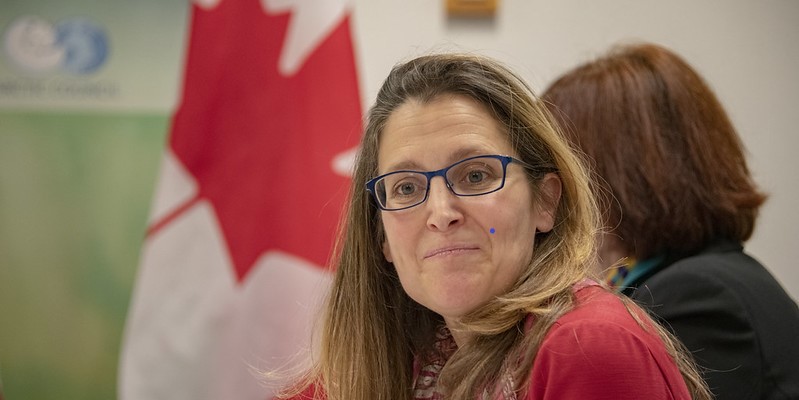Canada’s economy is not booming—it’s stagnating

In the latest example of a recurring theme, federal Finance Minister Chrystia Freeland, speaking during a recent event in Quebec City, touted Canada’s economic growth, the “strongest” in the G7, and said she’s “never been more optimistic about the future” of the Canadian economy. In other words, the economy is booming.
It’s hard to overstate the misleading nature of this narrative, which the Trudeau government has been repeating for months. In reality, Canada’s economy has largely stagnated—that is, economic growth has declined dramatically—and all signs point to this negative trend continuing for the foreseeable future.
Since taking office, the Trudeau government’s plan to grow the economy has largely focused on two things—expanding the population and increasing the role of government.
Canada’s population grew by 2.7 per cent from January 2022 to January 2023, which is the highest rate since 1957 and the post-war baby boom. And federal per-person (inflation-adjusted) program spending is projected to grow from $9,038 in 2014 to $11,476 in 2023, an increase of 27.0 per cent in about a decade, with the Trudeau government on track to record the six highest years of per-person spending in Canadian history.
While the size of the population and federal spending have both risen significantly, growth in real incomes and living standards has stalled. Pre-COVID, between 2016 and 2019, the Trudeau government compared poorly with previous federal governments during comparable pre-recession periods on almost any measure of economic growth.
For instance, after adjusting for inflation, growth in per-person GDP (a key indicator of incomes and living standards) averaged only 0.8 per cent in the four years preceding the 2020 recession, lagging behind growth rates during the Harper, Martin, Chrétien and Mulroney governments during comparable pre-recessionary periods. The Chrétien period, which was defined by smarter and smaller government spending, experienced per-person GDP growth of 3.7 per cent, which is 4.8 times greater than in the Trudeau era.
Post-COVID, the economy has stagnated. Canada’s per-person GDP (adjusted for inflation) in 2019 stood at $56,206, declined sharply in 2020 before recouping some of the losses in 2021. However, despite economic recovery from COVID, by the third quarter of 2022, GDP per person remained below pre-pandemic levels. And with an expected population growth of 1.4 per cent and the Trudeau government projecting GDP growth (inflation-adjusted) of just 0.3 per cent in 2023, more declines are coming. Clearly, there’s obvious (and worrying) stagnation in living standards for Canadians.
And that’s not all. Business investment—spending on equipment, machinery, factories and new technologies—is another key driver of income gains and living standards. According to recent research, from 2014 to 2021, business investment per worker in Canada (adjusted for inflation) declined by 20 per cent from $18,363 to $14,687.
By comparison, during that same time period in the United States, business investment per worker (adjusted for inflation, in Canadian dollars) actually increased from $23,333 to $26,751. Now, business investment per worker in Canada is equal to only 54.9 per cent of U.S. levels.
Again, without a change in economic strategy, Canada is destined for more calamity in the coming decades. A study by the Organisation for Economic Co-operation and Development (OECD) found that Canada will record the lowest level of per-person GDP growth among 32 advanced economies during the periods 2020 to 2030 and 2030 to 2060. Countries such as Czechia, Estonia, Israel, South Korea, New Zealand, Slovenia and Turkey, which currently have lower levels of average per-person GDP, are expected to vault past Canada and achieve higher living standards by 2060.
Despite any claims by Minister Freeland and the Trudeau government, Canada faces serious and long-term economic challenges. The government’s policies have sought to grow the country’s economy almost exclusively by boosting the population and increasing the role of government, but this plan has failed to deliver prosperity for Canadians. To boost productivity, business investment and economic growth before Canada drifts too far off road, Ottawa needs a serious course correction.
Authors:
Subscribe to the Fraser Institute
Get the latest news from the Fraser Institute on the latest research studies, news and events.


